Montana hosts an impressive array of woodpecker species, boasting a total of 11 unique representatives in its diverse ecosystems.
The state provides a haven for these charismatic birds, from the vibrant Downy and Pileated Woodpeckers to the elusive American Three-toed and Black-backed Woodpeckers.
Each species brings its own set of distinctive traits, contributing to the intricate tapestry of Montana’s wildlife.
This comprehensive exploration delves into the fascinating lives of these woodpeckers, unveiling their roles in maintaining ecological balance, preferred habitats, and the challenges they face.
Join us on a journey through Montana’s woodlands as we unravel these avian inhabitants’ captivating stories and emphasize their conservation’s importance in preserving the state’s natural heritage. Stay sharp.
11 Woodpeckers in Montana
Montana’s diverse woodpecker population adds vibrancy to its ecosystems. From the striking Black-backed and American Three-toed Woodpeckers, with their unique habitat preferences, to the adaptable White-headed Woodpecker, each species plays a crucial role in maintaining forest health.
Discover the fascinating world of these woodpeckers as we delve into their distinctive characteristics and lifestyles.
1. Downy Woodpecker
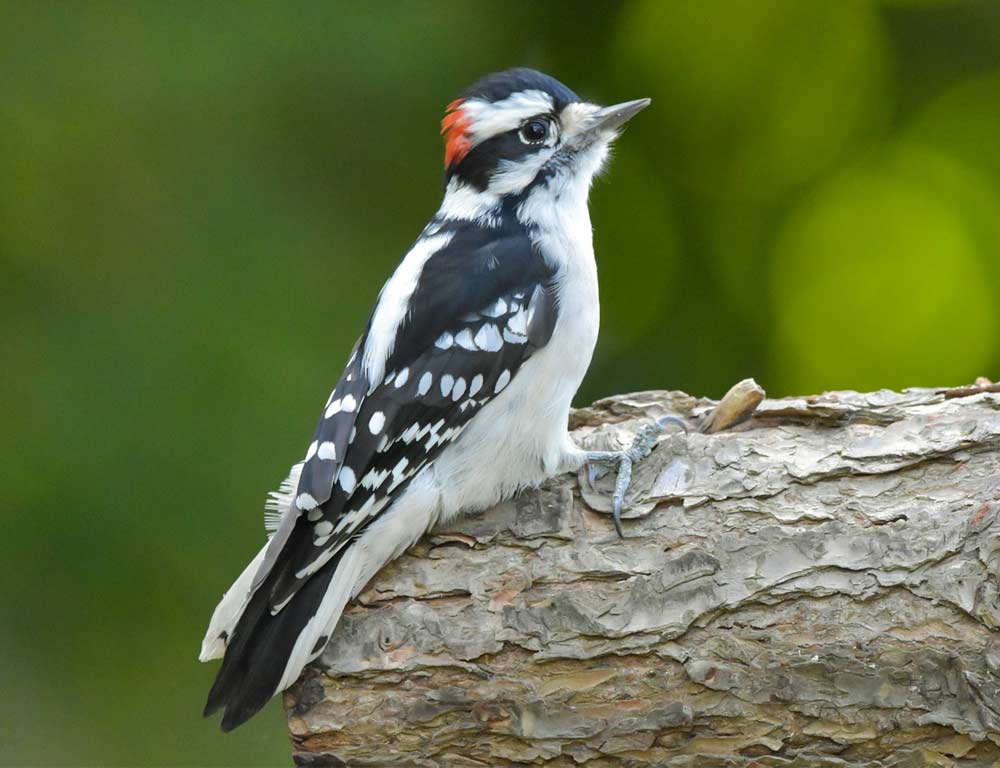
- Scientific Name: Picoides pubescens
- Category: Picidae (Woodpeckers)
- Population: Common
- Life Span: 4-12 years
- Size: 6-7 inches
- Weight: 0.7-1.0 ounces
- Food: Insects, seeds, berries
- Wingspan: 9-12 inches
- Status: Stable
The Downy Woodpecker, with its distinctive black-and-white plumage and small size, is common in Montana’s woodlands. They thrive in a variety of habitats, from forests to suburban areas.
These agile birds are adept at foraging for insects and larvae on tree trunks and branches. With a lifespan of 4-12 years, Downy Woodpeckers are resilient members of Montana’s avian community.
They prefer open woodlands and can often be found in backyard gardens, especially attracted to suet feeders. Their rhythmic drumming and high-pitched calls resonate through the forest, contributing to the region’s natural soundtrack.
Downy Woodpeckers are vital in controlling insect populations, making them valuable to the ecosystem. Despite habitat changes, their stable population status indicates adaptability and successful coexistence with human-altered landscapes.
2. Pileated Woodpecker
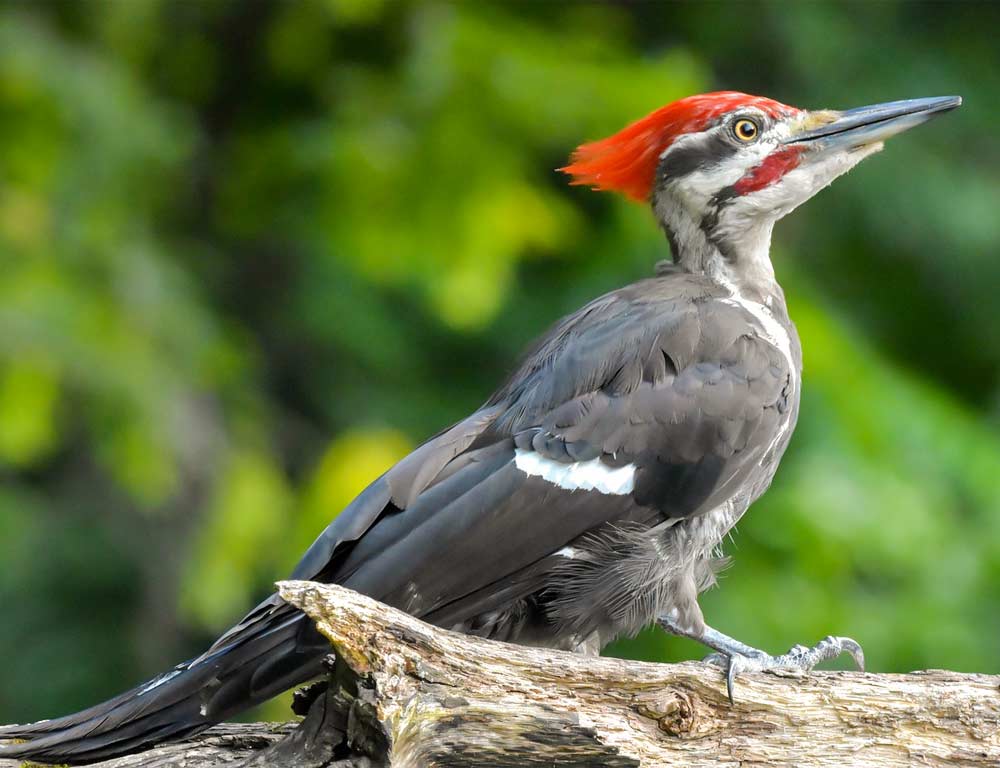
- Scientific Name: Dryocopus pileatus
- Category: Picidae (Woodpeckers)
- Population: Stable
- Life Span: 7-10 years
- Size: 16-19 inches
- Weight: 8-12 ounces
- Food: Insects, fruits, nuts
- Wingspan: 26-30 inches
- Status: Least Concern
The impressive Pileated Woodpecker is a charismatic inhabitant of Montana’s mature forests. This large woodpecker is hard to miss with its striking black and red crest.
Pileated Woodpeckers have a robust build, reaching sizes of 16-19 inches, and contribute to the rich biodiversity of Montana’s woodlands.
Known for their distinctive drumming and loud calls, these woodpeckers play an essential role in maintaining the balance of the ecosystem. Their primary food sources include insects, fruits, and nuts.
With a lifespan of 7-10 years, Pileated Woodpeckers establish territories in large, unfragmented forests where they construct sizable cavities in trees for nesting.
Montana’s stable Pileated Woodpecker population suggests a harmonious coexistence with its environment, although ongoing conservation efforts are crucial for maintaining healthy habitats.
3. Red-headed Woodpecker
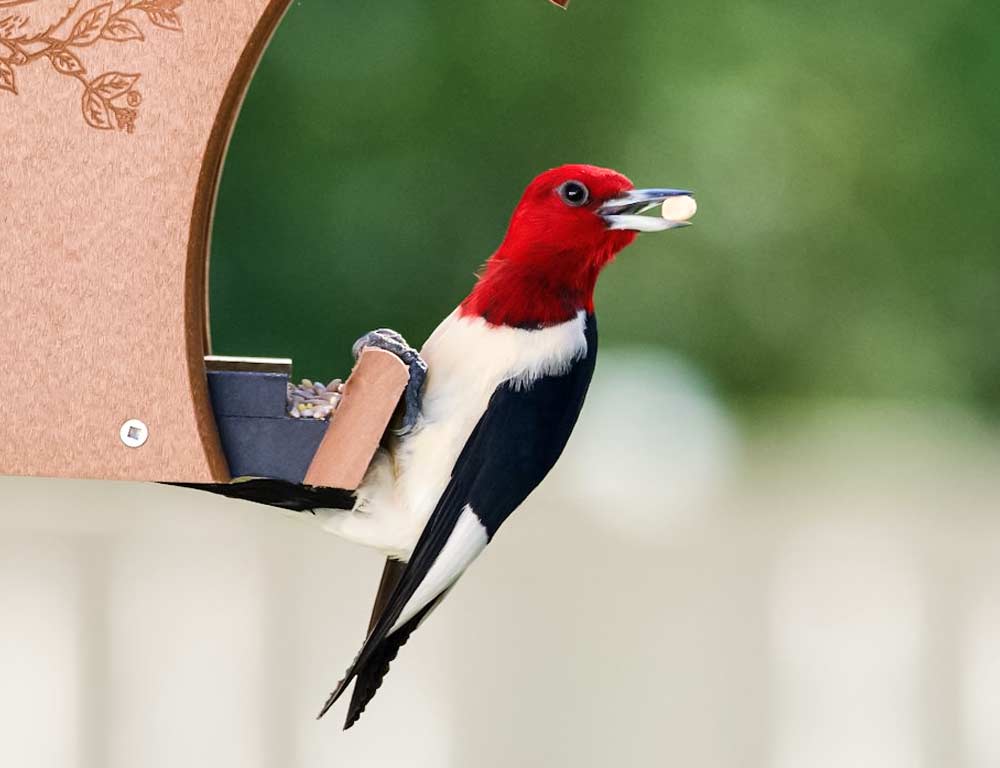
- Scientific Name: Melanerpes erythrocephalus
- Category: Picidae (Woodpeckers)
- Population: Declining
- Life Span: 9-12 years
- Size: 7.5-9.1 inches
- Weight: 2-3 ounces
- Food: Insects, fruits, seeds
- Wingspan: 16.5-17.7 inches
- Status: Near Threatened
The Red-headed Woodpecker, with its vibrant plumage and distinct appearance, graces Montana’s landscapes, though sadly, its population is declining.
These woodpeckers, measuring 7.5-9.1 inches, are known for their striking redheads, contrasting with their black and white bodies.
Red-headed Woodpeckers have a varied diet, feeding on insects, fruits, and seeds. Their decline in numbers raises concerns about habitat loss and environmental changes.
With a lifespan of 9-12 years, these woodpeckers face challenges in finding suitable nesting sites and food sources.
Conservation efforts are vital to reversing their declining status, ensuring the continued presence of these charismatic birds in Montana’s ecosystems.
Providing habitat protection and addressing factors contributing to their decline will be crucial for the region’s long-term survival of the Red-headed Woodpecker.
4. Yellow-bellied Sapsucker
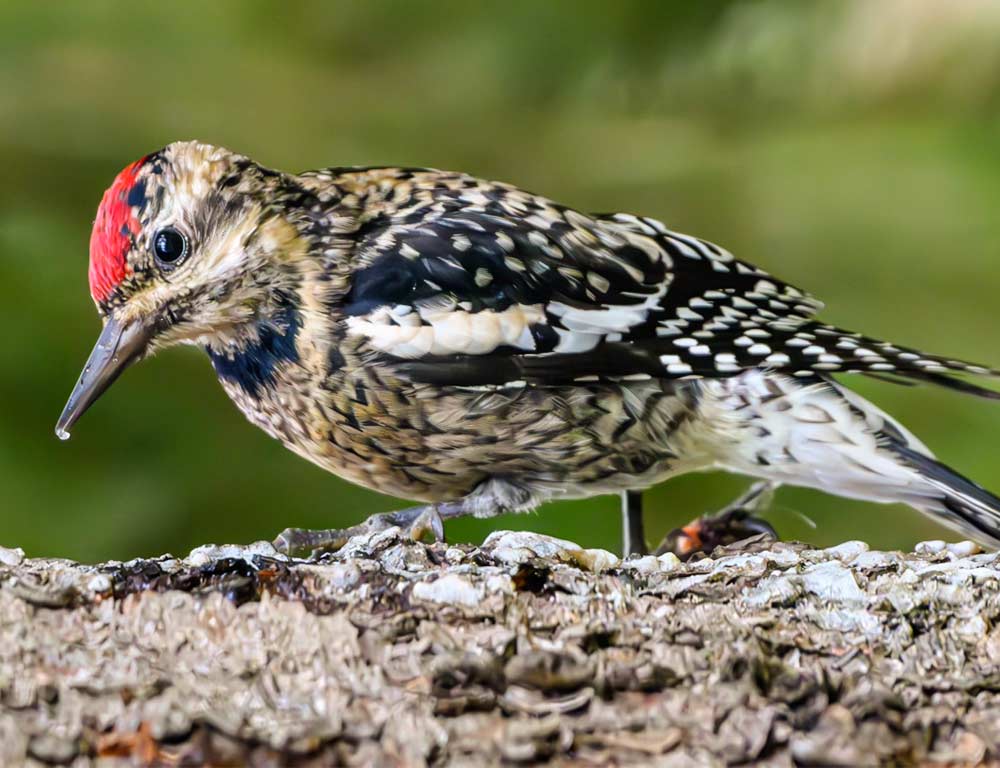
- Scientific Name: Sphyrapicus varius
- Category: Picidae (Woodpeckers)
- Population: Stable
- Life Span: 4-9 years
- Size: 7-9 inches
- Weight: 1.5-2.5 ounces
- Food: Tree sap, insects
- Wingspan: 13-16 inches
- Status: Least Concern
The Yellow-bellied Sapsucker is a distinctive woodpecker found in Montana’s forests, characterized by its black and white plumage and red forehead and throat.
These medium-sized birds, measuring 7-9 inches, have a stable population, reflecting their adaptability to various habitats.
Yellow-bellied Sapsuckers earned their name from their unique feeding behavior. They drill shallow holes in trees to feed on sap and also consume insects attracted to the sap wells.
This feeding strategy sets them apart from other woodpeckers. With a 4-9 years lifespan, these sapsuckers are integral to the ecosystem, influencing tree health and providing a food source for other species.
5. Northern Flicker
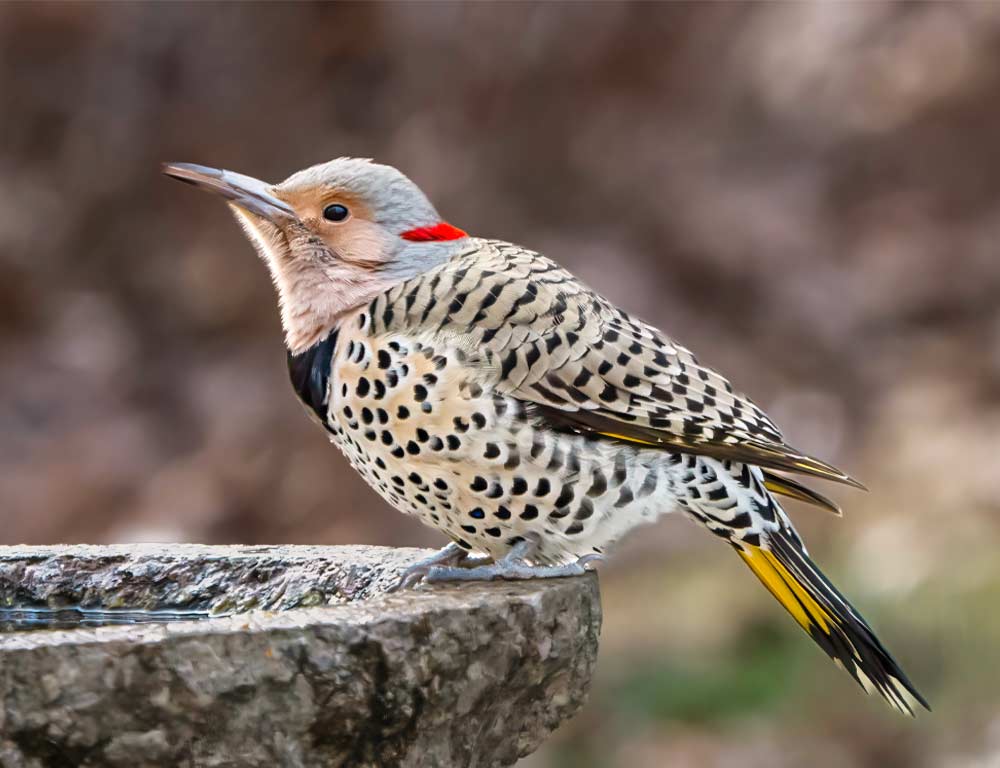
- Scientific Name: Colaptes auratus
- Category: Picidae (Woodpeckers)
- Population: Abundant
- Life Span: 6-11 years
- Size: 11-14 inches
- Weight: 3-5 ounces
- Food: Insects, fruits, seeds
- Wingspan: 17-21 inches
- Status: Least Concern
The Northern Flicker is a widespread and abundant woodpecker in Montana, known for its distinctive plumage featuring a spotted belly and a black crescent on its chest.
Northern Flickers are easily identifiable with a size ranging from 11-14 inches. These woodpeckers have diverse feeding habits, consuming insects, fruits, and seeds.
Their ground-feeding behavior distinguishes them from other woodpecker species. Northern Flickers contribute to pest control by consuming large quantities of ants and beetles.
With a lifespan of 6-11 years, these adaptable birds have successfully integrated into various habitats, including forests, urban areas, and open landscapes.
6. Red-naped Sapsucker
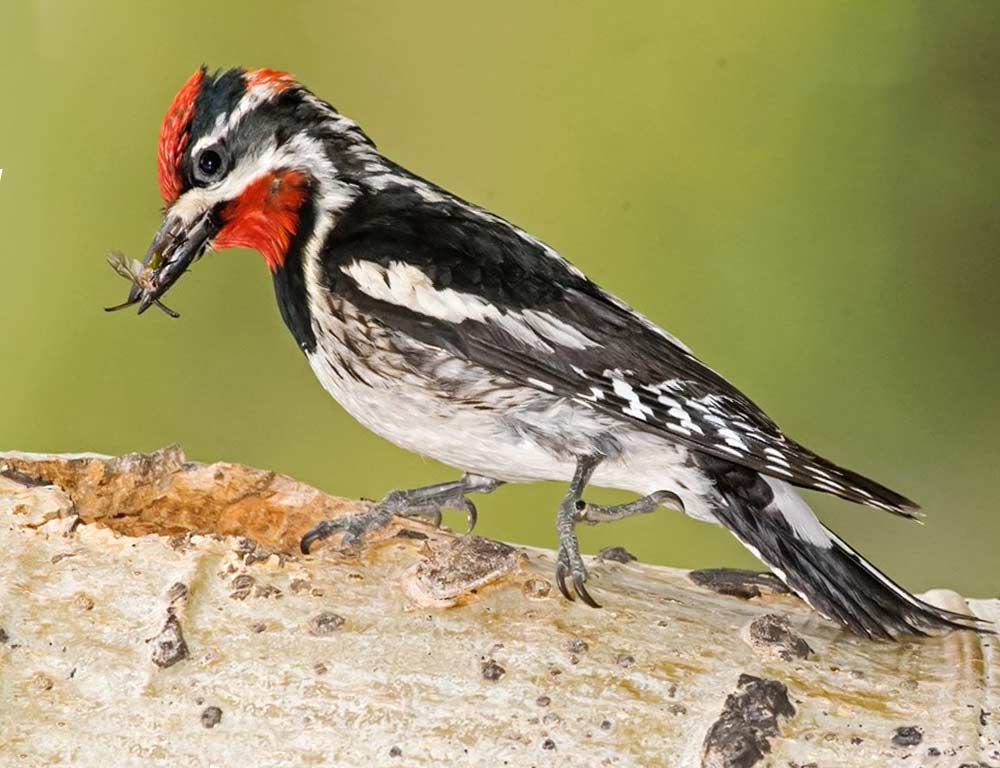
- Scientific Name: Sphyrapicus nuchalis
- Category: Picidae (Woodpeckers)
- Population: Declining
- Life Span: 4-9 years
- Size: 7-8.5 inches
- Weight: 1.5-2.5 ounces
- Food: Tree sap, insects
- Wingspan: 13-16 inches
- Status: Near Threatened
The Red-naped Sapsucker, identified by its red nape and throat, is a woodpecker facing population decline in Montana. Measuring 7-8.5 inches, these birds have a specialized diet, feeding on tree sap and insects.
Like the Yellow-bellied Sapsucker, the Red-naped Sapsucker drills sap wells in trees, contributing to their declining population status.
Their decline may be attributed to habitat loss and environmental changes impacting their food sources.
Conservation efforts are crucial to addressing these challenges and ensuring the survival of the Red-naped Sapsucker in Montana’s ecosystems.
Protecting their habitats and raising awareness about the importance of these woodpeckers will be essential for their long-term conservation.
7. Williamson’s Sapsucker
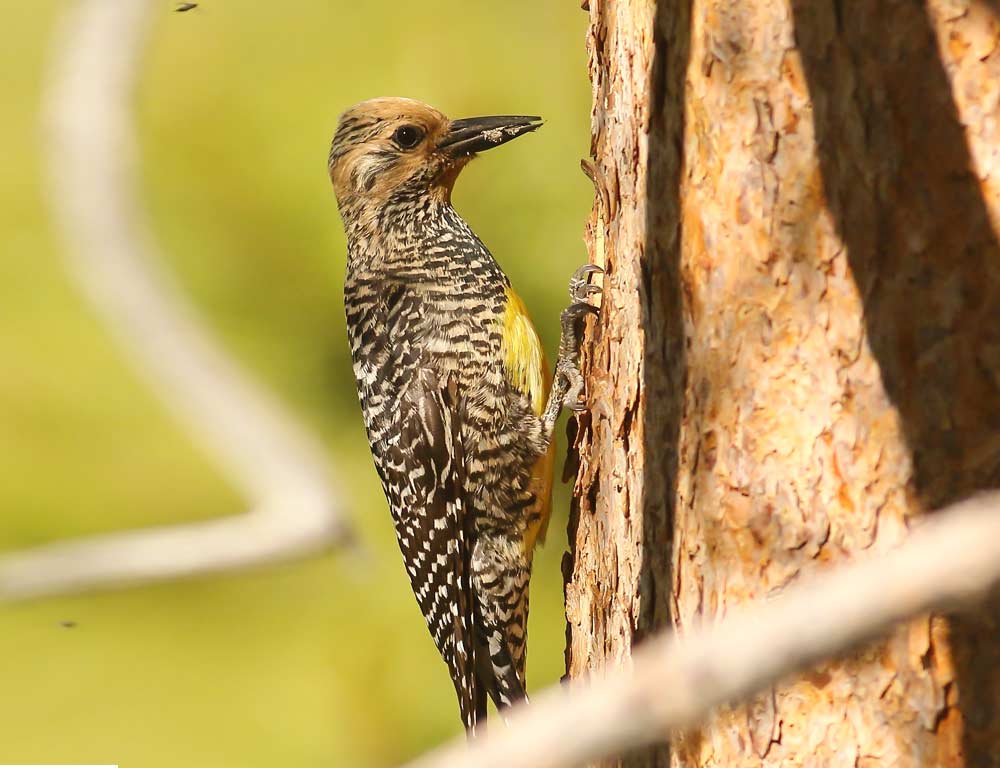
- Scientific Name: Sphyrapicus thyroideus
- Category: Picidae (Woodpeckers)
- Population: Declining
- Life Span: 4-7 years
- Size: 8-10 inches
- Weight: 2-3 ounces
- Food: Tree sap, insects
- Wingspan: 18-22 inches
- Status: Near Threatened
Williamson’s Sapsucker is a distinctive woodpecker with a black and white plumage, males featuring a red throat and females with a yellow throat.
Found in montane coniferous forests, these woodpeckers face a declining population, highlighting the need for conservation efforts.
Measuring 8-10 inches, Williamson’s Sapsucker feeds on tree sap and insects by drilling characteristic sap wells.
These sapsuckers play a vital role in forest ecosystems by creating habitat for other wildlife and influencing tree health. The decline in their population may be attributed to habitat loss and changes in forest management practices.
Conservation measures should focus on preserving suitable habitats, ensuring sustainable forest management, and raising awareness about the importance of Williamson’s Sapsucker in maintaining ecological balance.
8. Lewis’s Woodpecker
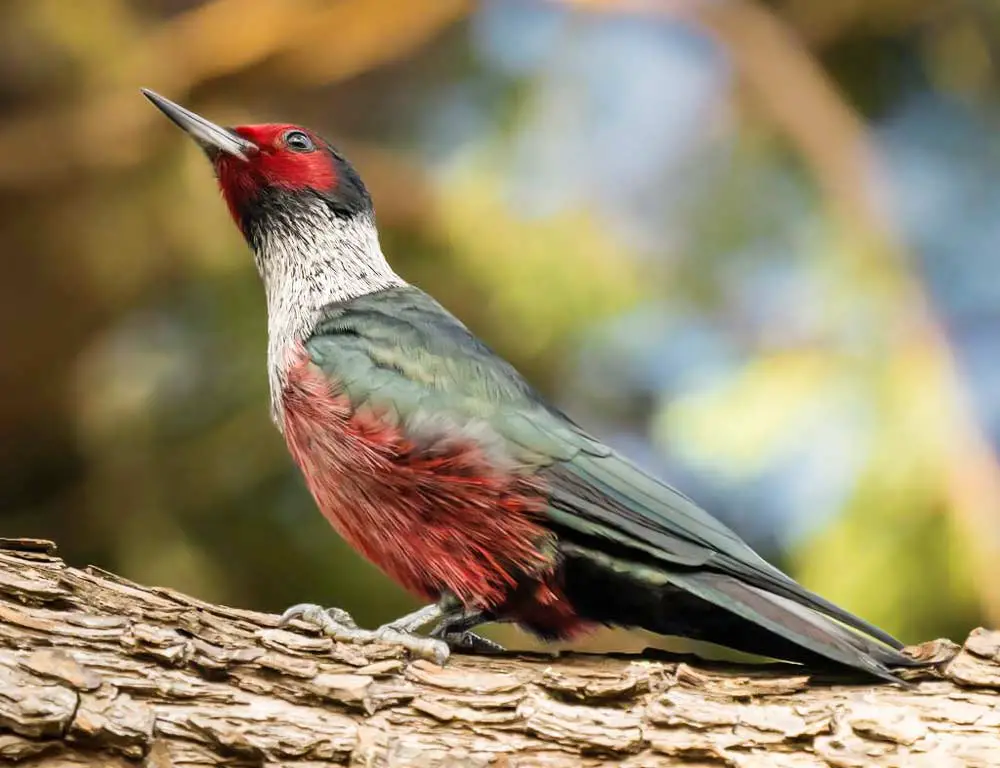
- Scientific Name: Melanerpes lewis
- Category: Picidae (Woodpeckers)
- Population: Stable
- Life Span: 6-8 years
- Size: 10-11 inches
- Weight: 3-6 ounces
- Food: Flying insects, fruits
- Wingspan: 18-20 inches
- Status: Least Concern
Lewis’s Woodpecker is a striking bird with dark iridescent greenish-black plumage and a distinctive pink or red belly. Thriving in open woodlands, these woodpeckers have a stable population in Montana.
Measuring 10-11 inches, Lewis’s Woodpecker is known for its unique foraging behavior. Unlike typical woodpeckers, it catches flying insects on the wing and also consumes fruits.
Their habitat preferences include burned or open areas with abundant dead trees for nesting. With a lifespan of 6-8 years, Lewis’s Woodpeckers contribute to forest health and biodiversity.
Conservation efforts should focus on maintaining suitable habitats, especially areas with standing dead trees and promoting practices that support their foraging needs.
9. Black-backed Woodpecker
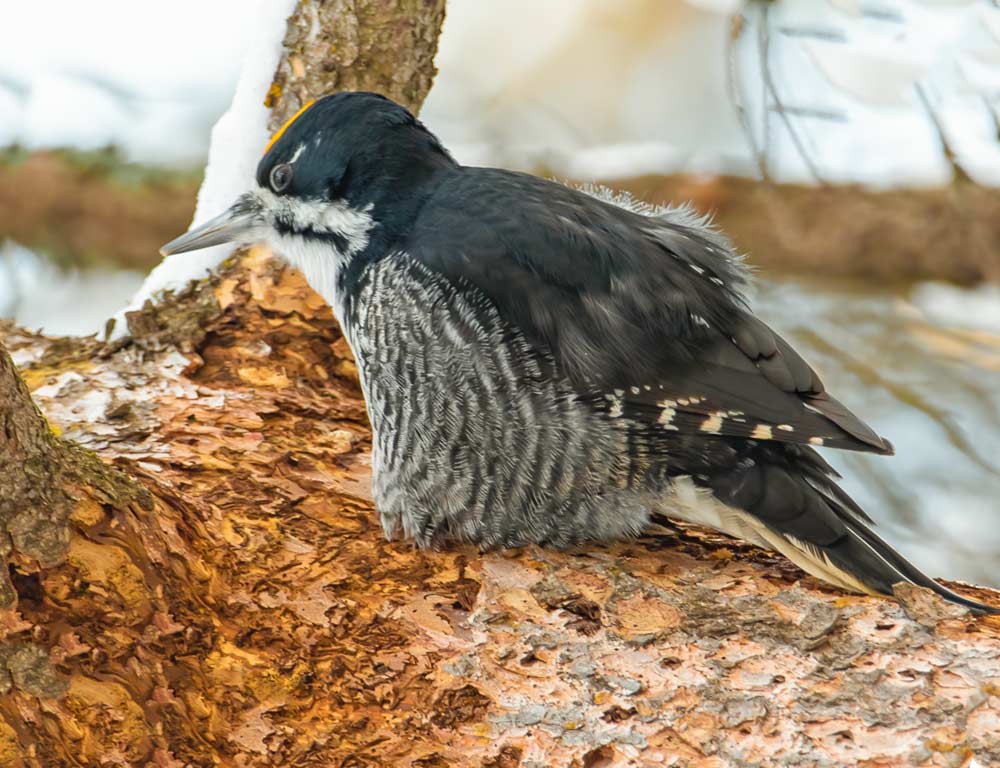
- Scientific Name: Picoides arcticus
- Category: Picidae (Woodpeckers)
- Population: Stable
- Life Span: 4-8 years
- Size: 8-9 inches
- Weight: 2-3 ounces
- Food: Insects, especially wood-boring beetles
- Wingspan: 14-16 inches
- Status: Least Concern
The Black-backed Woodpecker is well-adapted to boreal and subalpine forests, with a black back and white underparts. Their population remains stable, reflecting their specialized habitat preferences.
Measuring 8-9 inches, these woodpeckers play a crucial ecological role by foraging for wood-boring beetles. They often exploit recently burned or infested areas, utilizing dead trees for nesting.
Their presence aids in preventing insect outbreaks that could harm the forest. With a 4-8 years lifespan, Black-backed Woodpeckers are an integral part of Montana’s ecosystems, and conservation efforts should prioritize maintaining healthy, fire-affected habitats.
10. American Three-toed Woodpecker
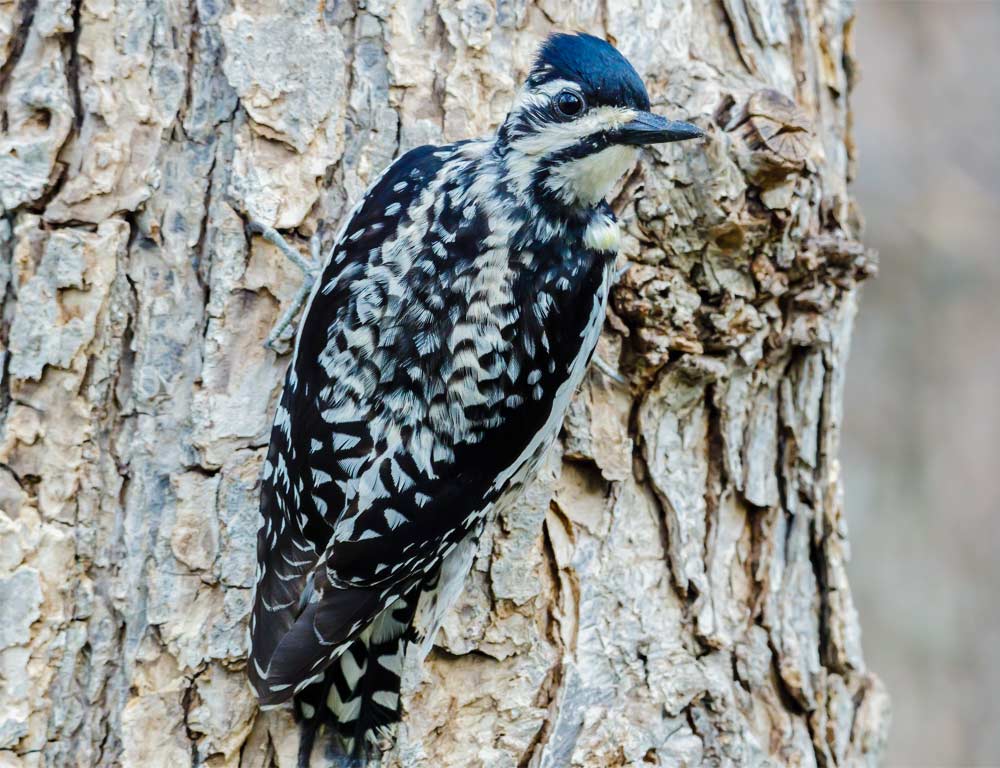
- Scientific Name: Picoides dorsalis
- Category: Picidae (Woodpeckers)
- Population: Declining
- Life Span: 4-7 years
- Size: 8-9 inches
- Weight: 2-3 ounces
- Food: Insects, especially wood-boring beetles
- Wingspan: 14-16 inches
- Status: Near Threatened
The American Three-toed Woodpecker, with its distinctive black and white plumage, is facing a declining population.
This 8-9 inches woodpecker shares similarities with the Black-backed Woodpecker, specializing in foraging for wood-boring beetles.
Their preferred habitats include coniferous forests, and their decline may be linked to habitat loss due to logging and changes in forest management.
Conservation efforts should focus on preserving mature coniferous forests with an emphasis on maintaining dead and decaying trees, which are essential for their foraging and nesting needs.
The American Three-toed Woodpecker’s role in controlling insect pests makes its conservation crucial for forest health.
11. White-headed Woodpecker
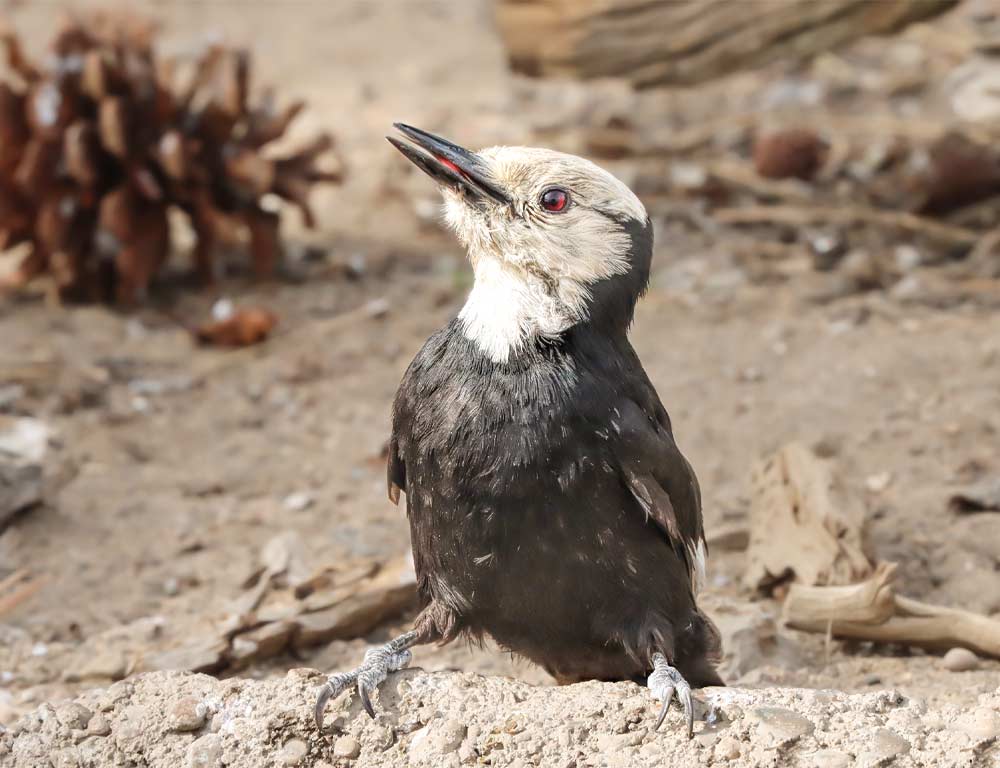
- Scientific Name: Dryobates albolarvatus
- Category: Picidae (Woodpeckers)
- Population: Stable
- Life Span: 6-10 years
- Size: 8-9 inches
- Weight: 2-3 ounces
- Food: Insects, seeds, berries
- Wingspan: 16-18 inches
- Status: Least Concern
The White-headed Woodpecker, characterized by its distinctive white head and black body, is a stable member of Montana’s woodpecker community.
Measuring 8-9 inches, these woodpeckers inhabit coniferous forests and play a role in maintaining ecosystem balance.
White-headed Woodpeckers contribute to forest biodiversity by feeding on insects, seeds, and berries. Their stable population status indicates successful adaptation to various habitats within their range.
Conservation efforts should focus on preserving mature coniferous forests and promoting sustainable forest management practices to ensure the continued well-being of the White-headed Woodpecker in Montana.
Wrapping Up
From the resilient Downy to the specialized Black-backed, Montana’s woodpeckers embody the state’s rich biodiversity. These charismatic birds, with their diverse lifestyles, contribute significantly to ecosystem health.
Conservation efforts are imperative to protect their habitats and ensure their continued presence in Montana’s landscapes.
Whether in the vast woodlands or suburban gardens, woodpeckers stand as avian ambassadors, illustrating the delicate balance of nature in the Treasure State. Thank you so much.